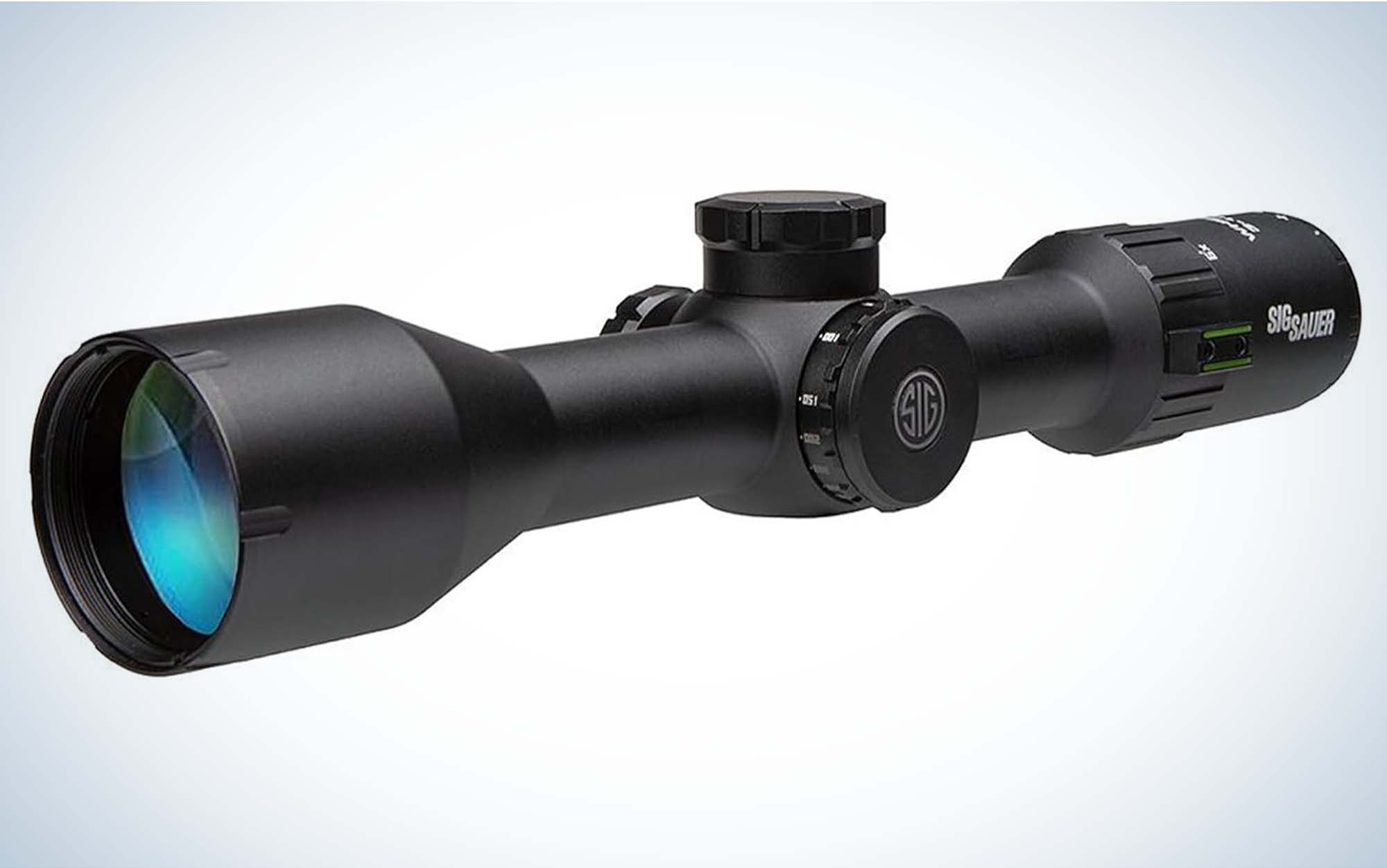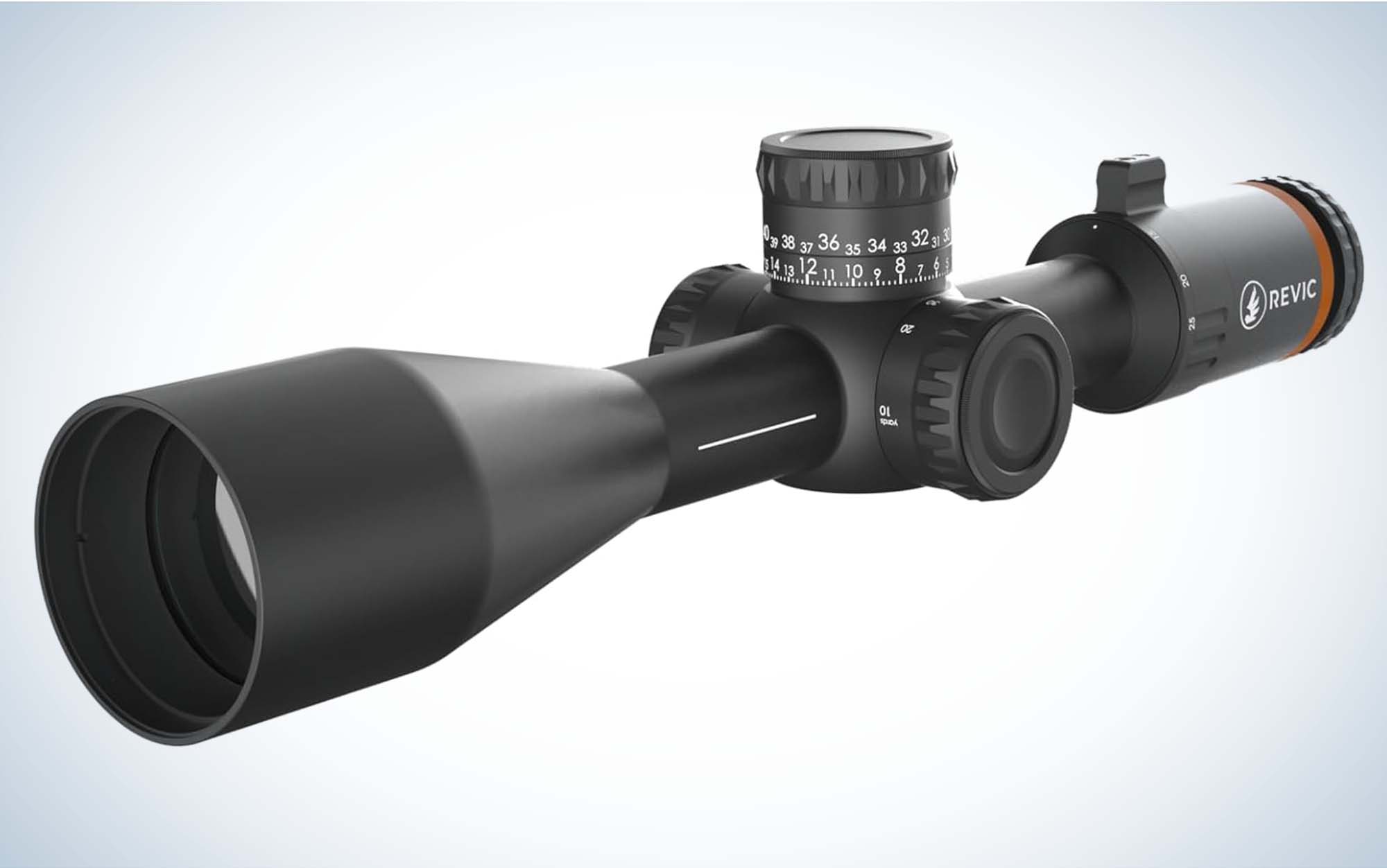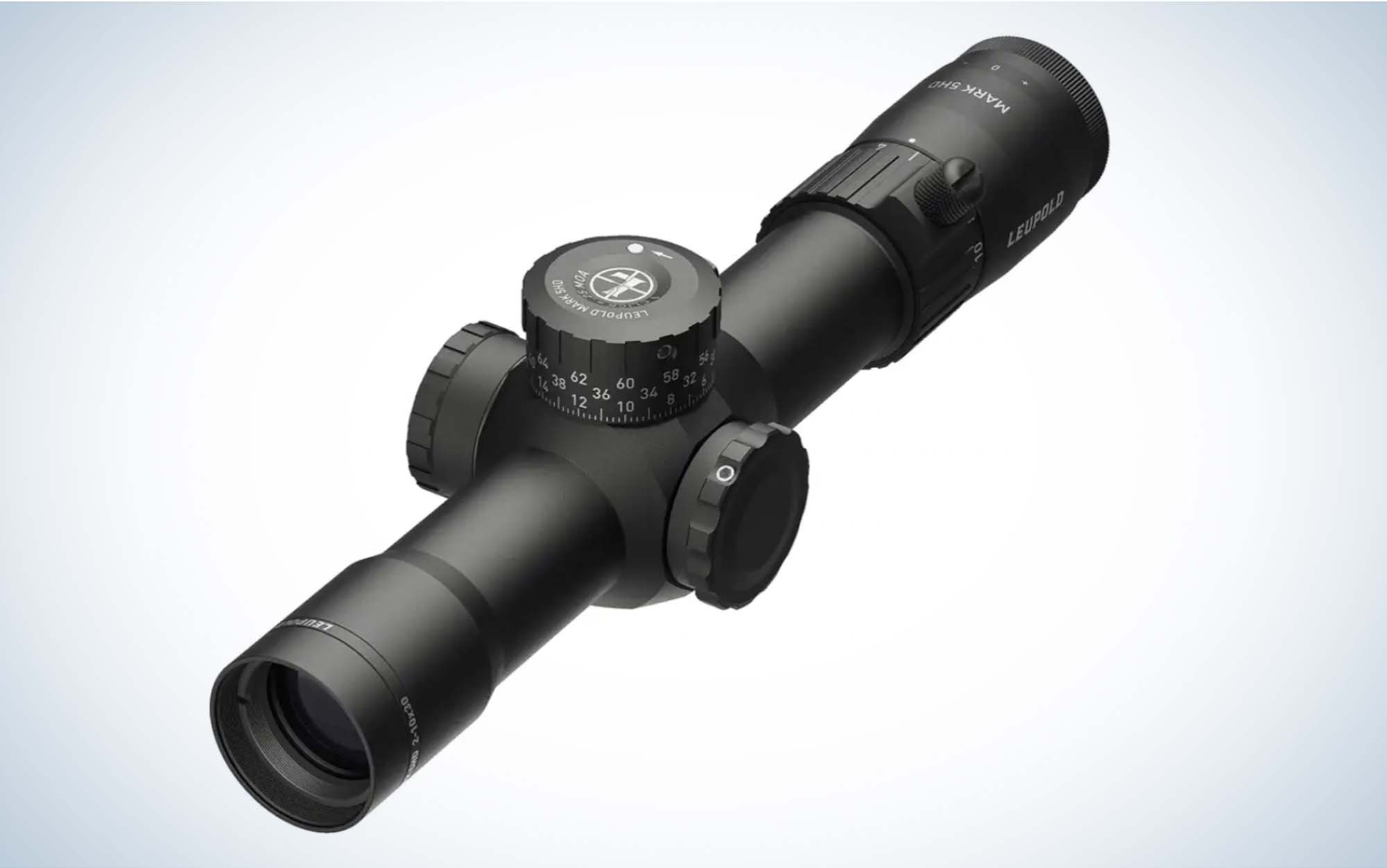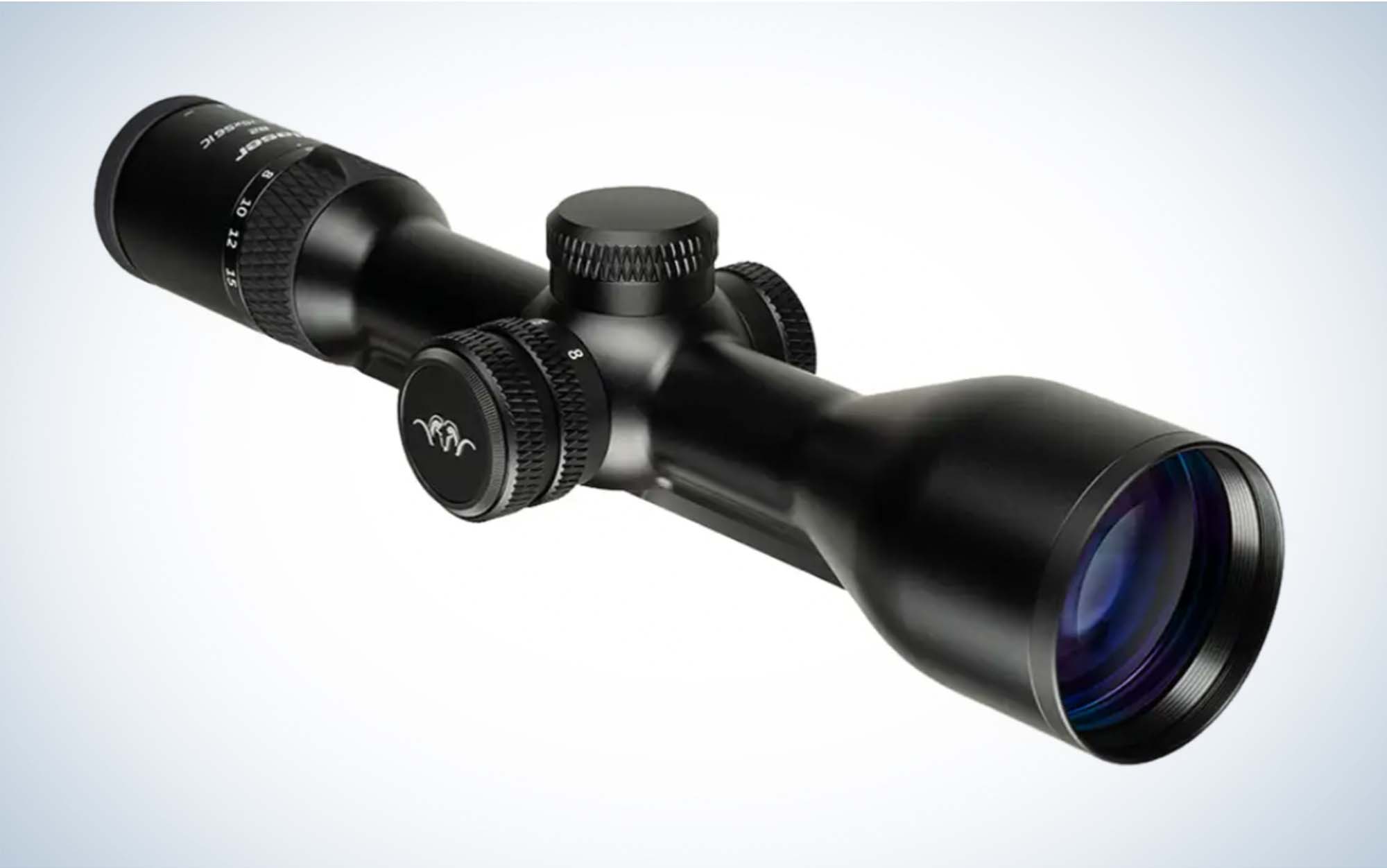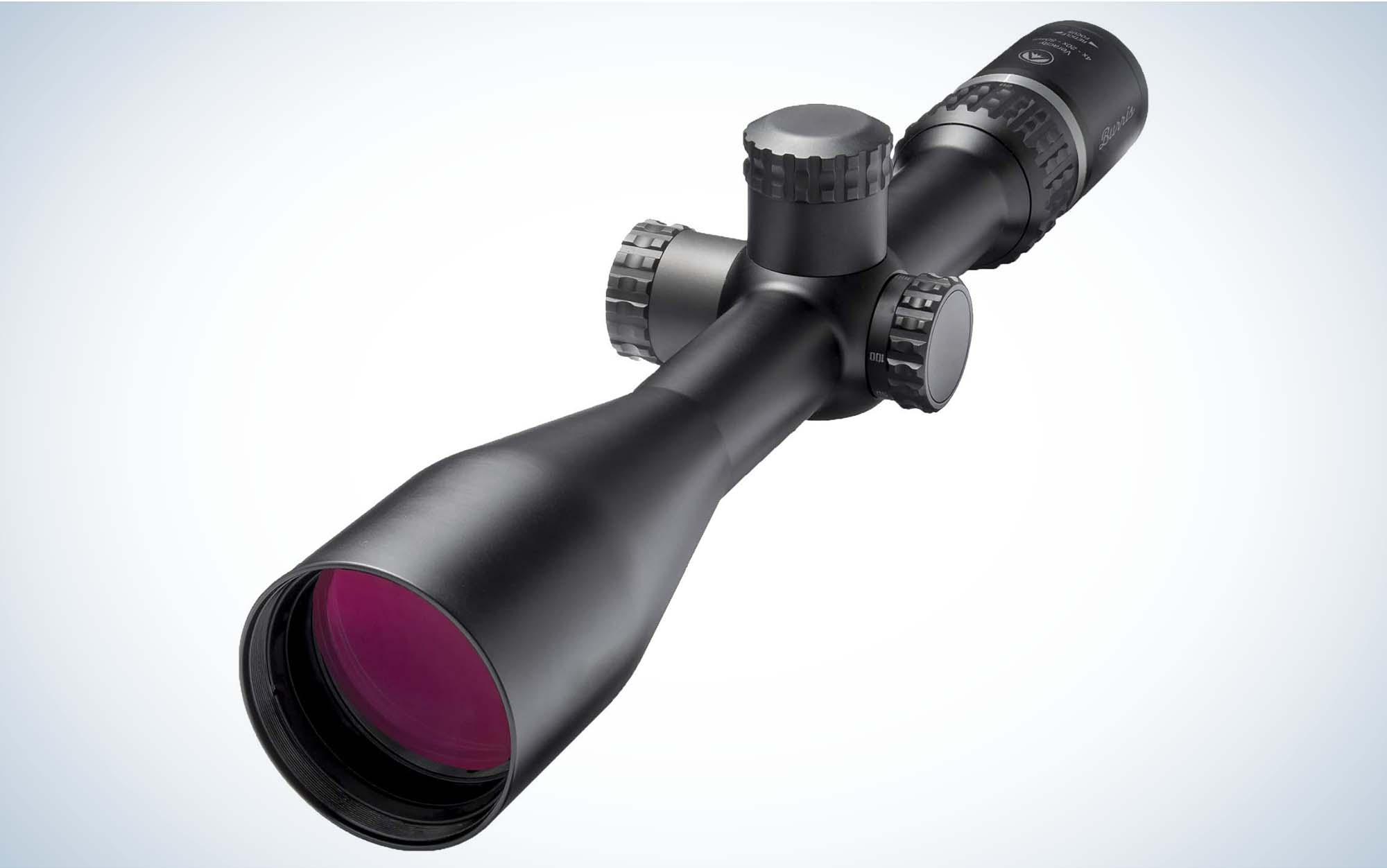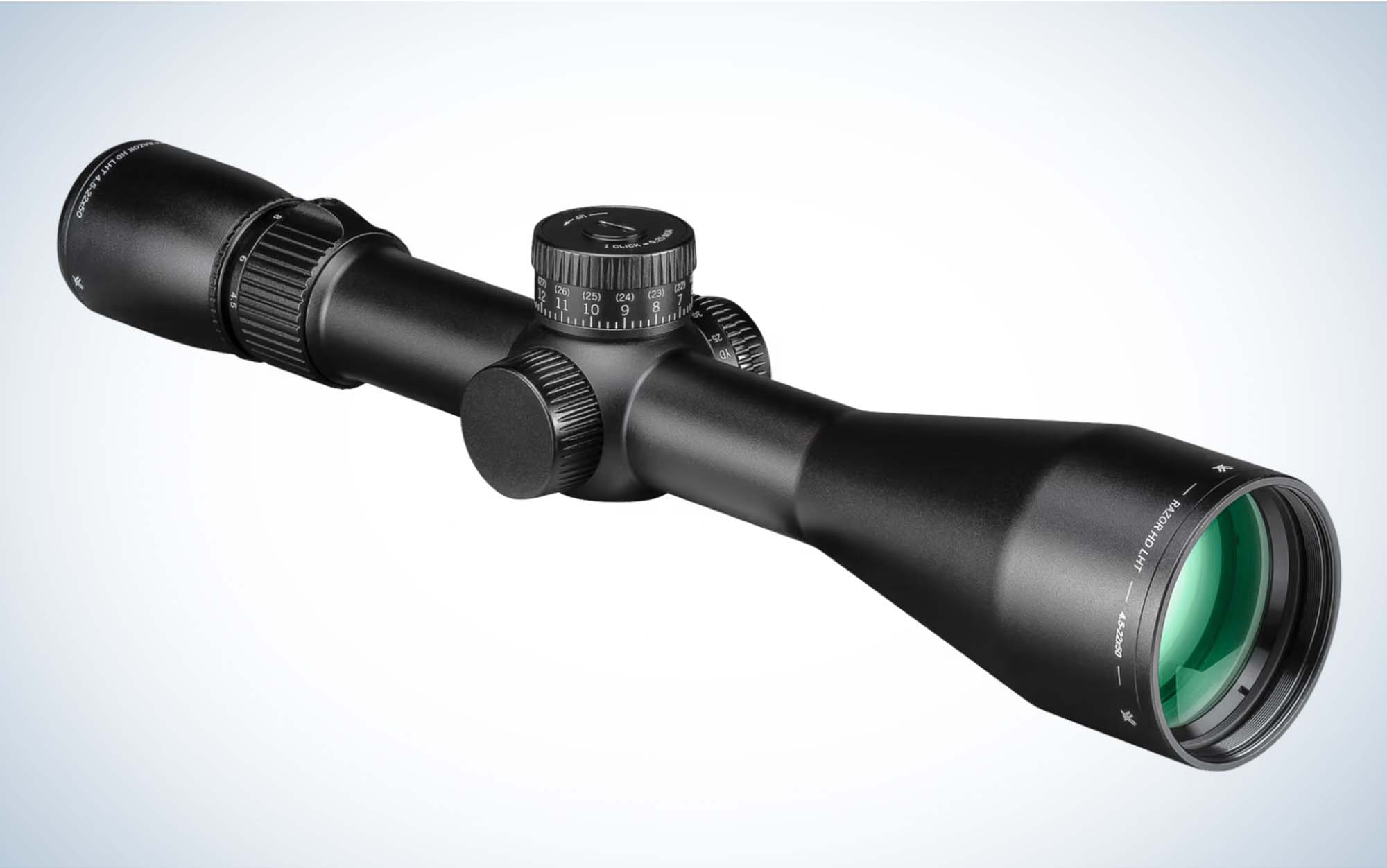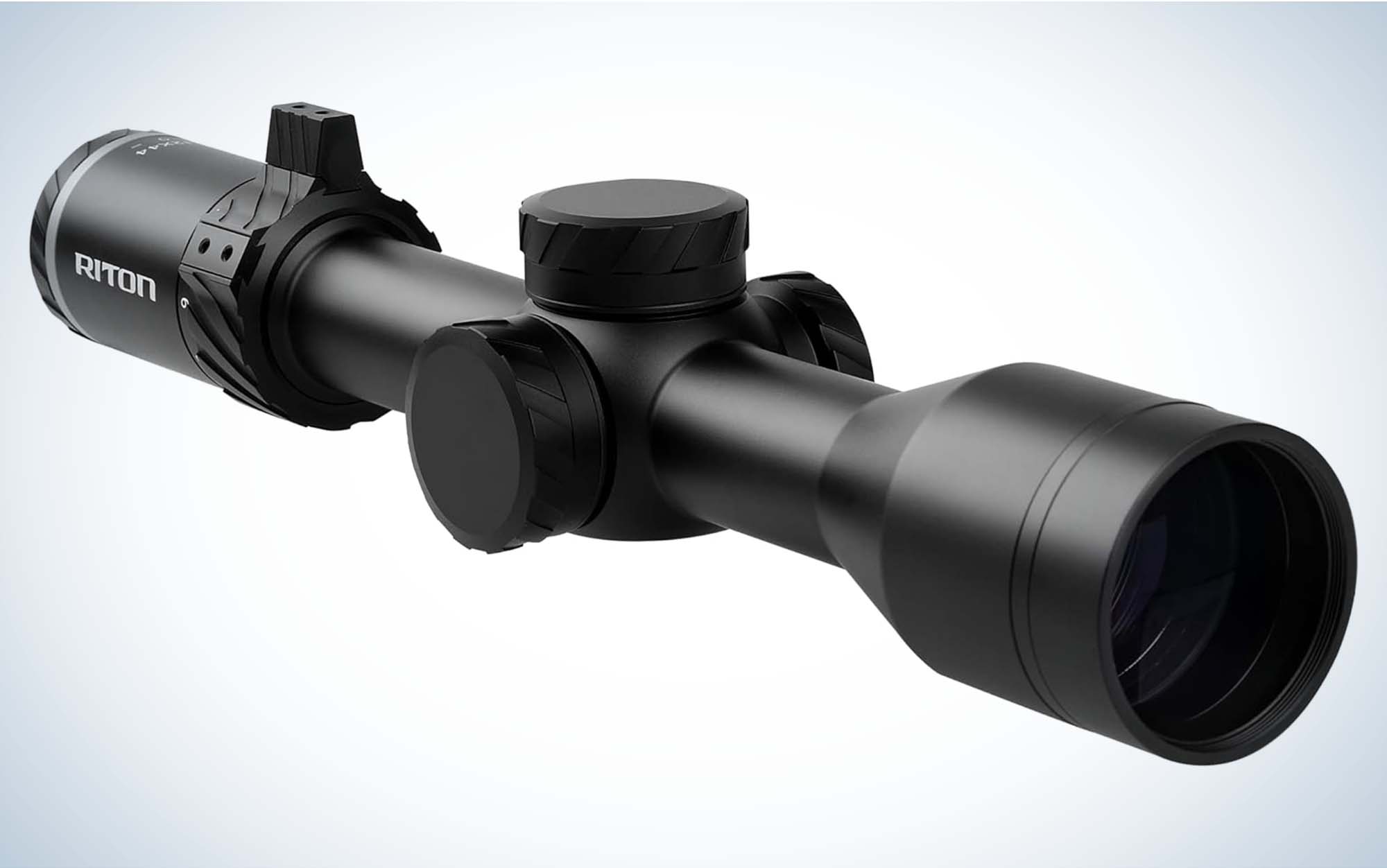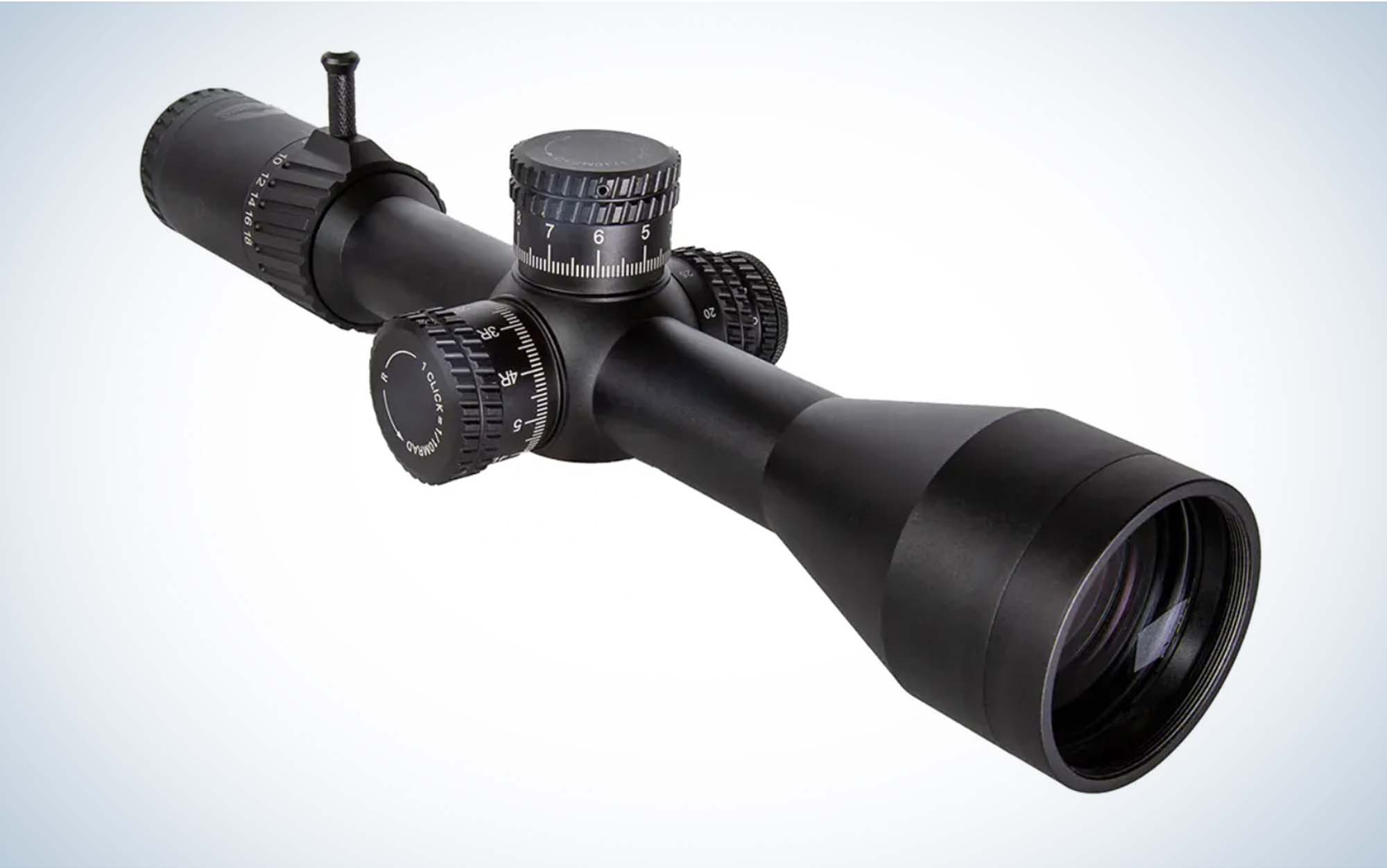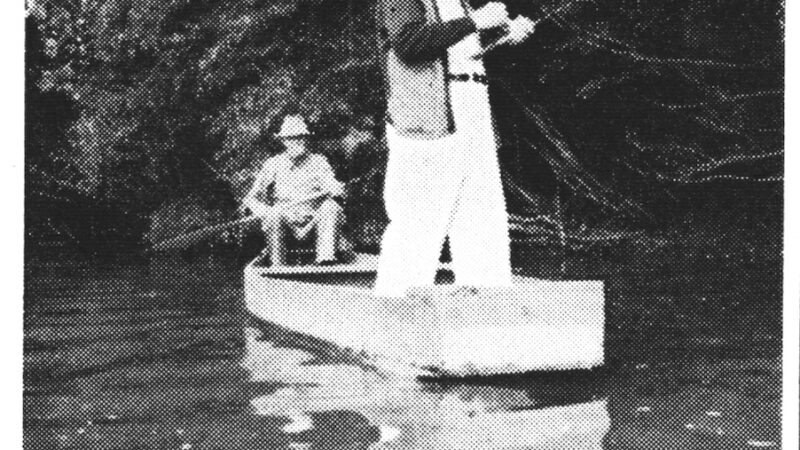The Best Hunting Scopes: 14 Modern and Versatile Options
Best Overall
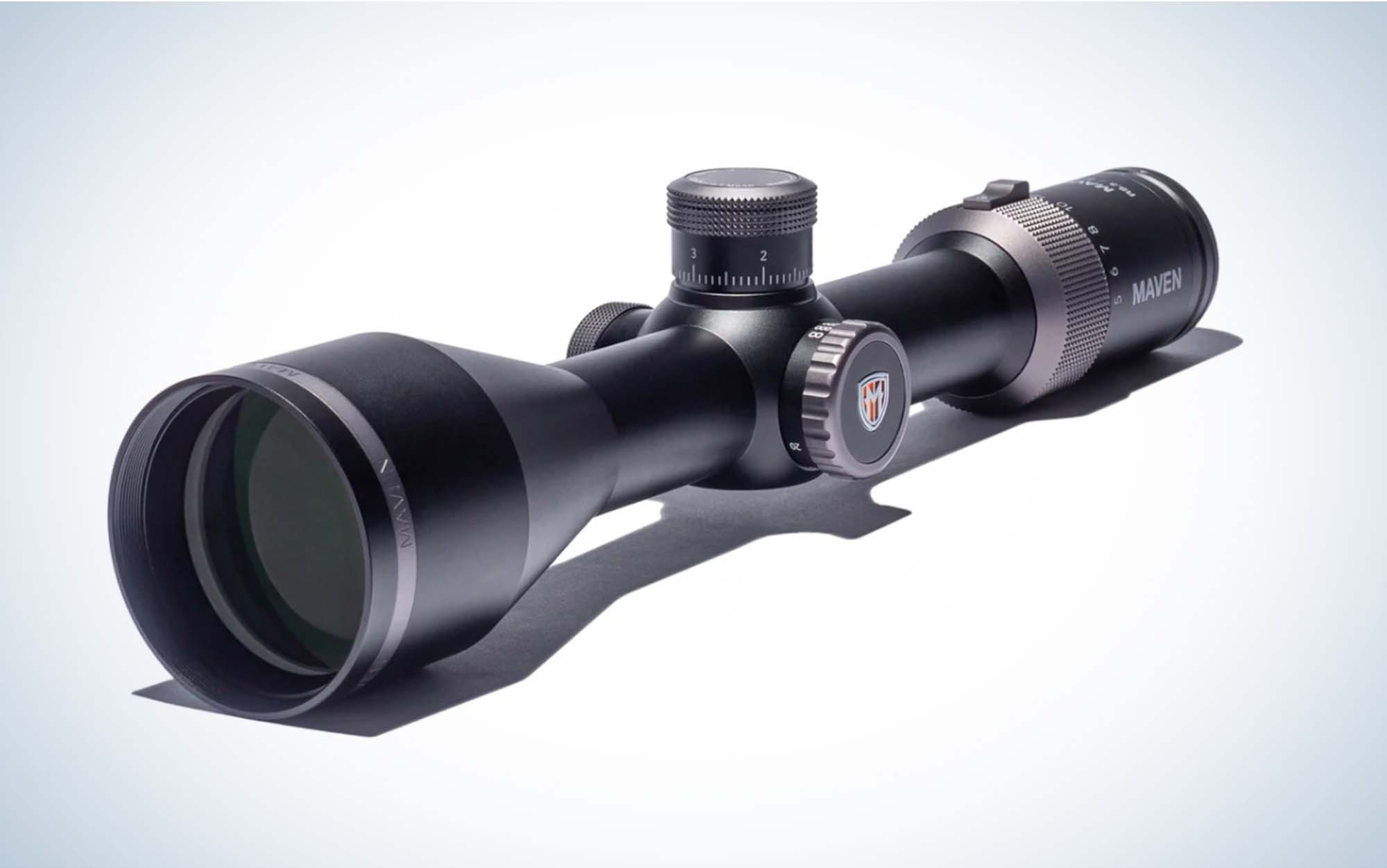
Maven RS3.2 5-30×50 FFP
Best Value
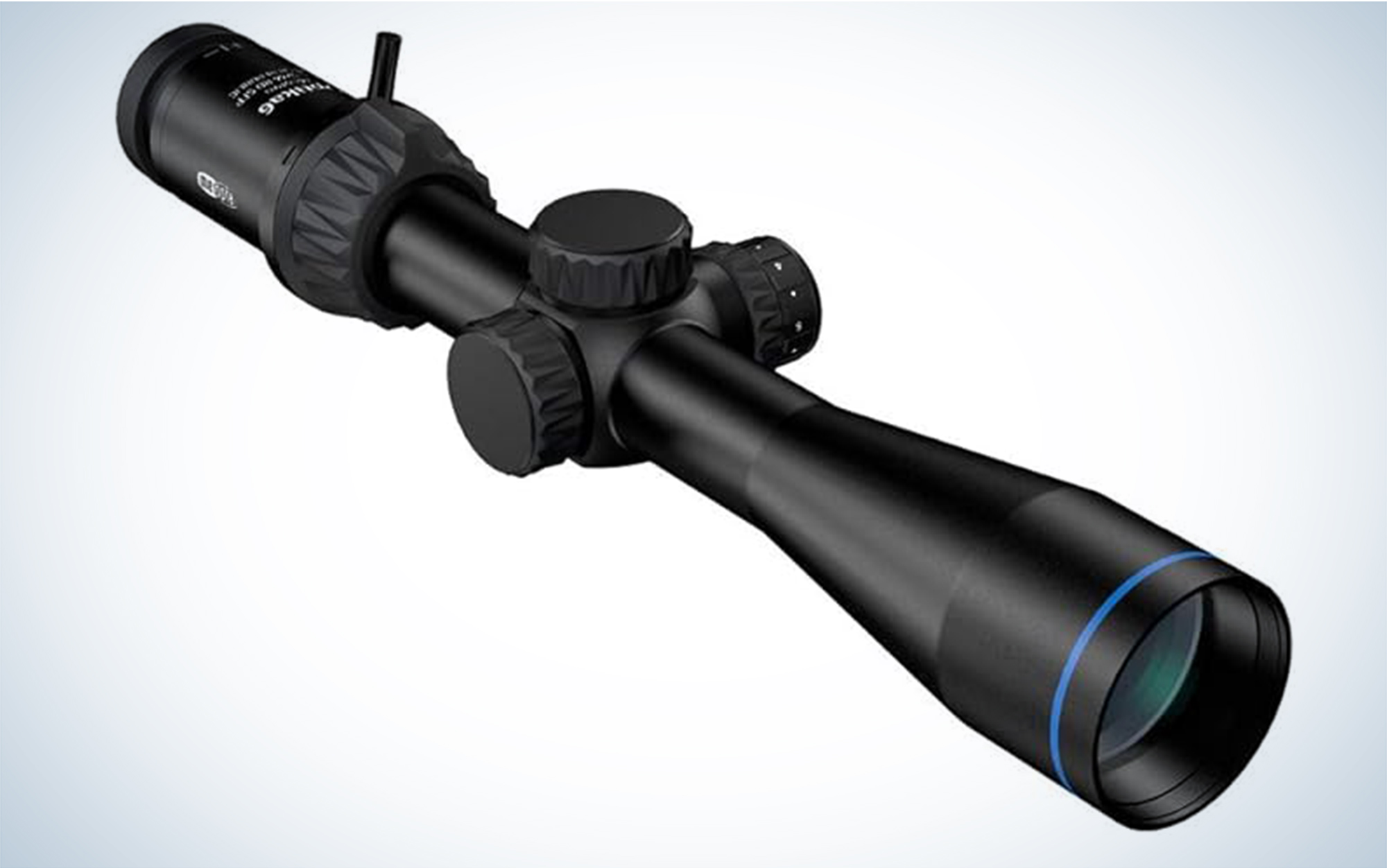
Meopta Optika6 2.5-15×44
Best for Elk Hunting
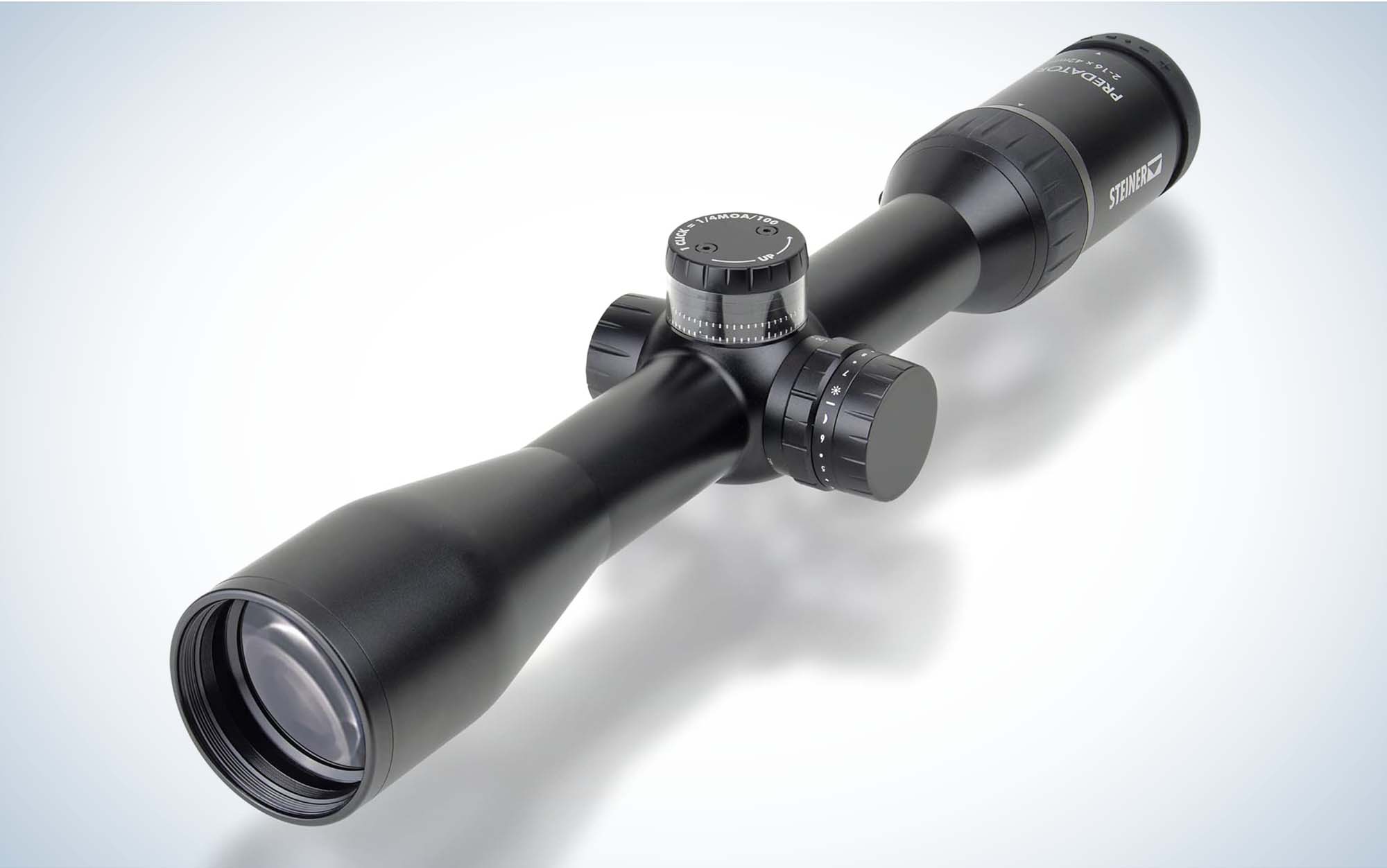
Steiner Predator 8 2-16×42
Over the past decade, hunting scopes have become increasingly specialized, to the degree that the idea of a single scope that several rifles might share is as quaint and unlikely as the notion of a stranger returning your lost wallet.
Exhibit A is the rise of purpose-driven precision scopes to satisfy the specific requirements of long-range target shooters. These are big scopes, usually built on 34mm tubes, with 56mm objective lenses and magnification in the 5-to-30-power range. They typically have first-plane reticles, oversized exposed turrets tuned to milliradian values, and weigh well over 2 pounds.
Exhibit B is the evolution of extremely lightweight hunting rifles, racing toward the 5-pound mark and promising sub-minute-of-angle accuracy. No mountain hunter worth their gaiters will mount a big scope on such a slender rifle. Instead, they’re looking for a lightweight scope with enough precision attributes to place bullets over long ranges, often at extreme angles, without overthinking a complicated reticle.
If it seems impossible to bridge the gap between those two shooting demands, then you haven’t been paying attention to the marketplace. We now have a bevy of versatile hunting scopes that can be mounted on a precision chassis rifle, a lightweight hunting rifle, a competition rimfire rifle, or even your favorite whitetail gun. Given that amount of versatility, these scopes are not only our new utility players, but they also represent a significant value proposition because of their ability to cross between platforms.
Outdoor Life’s optics test team gathered a full dozen new hunting scopes, and tested them alongside another 11 that have been on the market for a couple years, all in an effort to determine which are worth your attention and your money. Here’s an abbreviated list of the best hunting scopes that can do it all.
- Best Overall: Maven RS3.2 5-30×50 FFP
- Best Value: Meopta Optika6 2.5-15×44
- Best for Elk Hunting: Steiner Predator 8 2-16×42
- Best for Whitetail Hunting: Sig Sauer WHISKEY6 3-18×44
- Most Innovative: Revic Acura RS25i 5-25×50
- Best for Carbines: Leupold Mark 5HD 2-10×30
- Best Second-Plane: Leupold VX-5HD 3-15×44 CDS-ZL2
- Best Glass: Blaser B2 2-12×50
- Best Precision: Zeiss LRP S3 4-25×50
- Best for Western Big-Game: Tract Toric UltraHD 2.5-15×44
- Best Lightweight: Vortex Razor HD LHT 4.5-22×50
- Best Digital: Burris Veracity PH 4-20×50
- Best Redesigned: Riton 5 Primal 2-12×44
- Best Entry-Level: Sightmark Presidio 3-18×50
How We Tested the Best Hunting Scopes
Because rifle scopes are essentially aiming devices, we evaluate them on a different basis than binoculars or spotting scopes, optical instruments that have broader utility. We’re interested in the precision of a rifle scope, so our scoring criteria gives more weight to attributes that achieve that goal.
We invited new products for 2023, but we included a few scopes that have been on the market for a year or two to better evaluate this promising category’s evolution.
Testing Reticles and Tracking
We test optical performance, same as we do spotters and binoculars. But we spend more time on four criteria that we think are the beating heart of a solid rifle scope. Our “interior aiming system” considerations are reticle style and utility, illumination, reticle references, and visibility. Our “exterior aiming system” evaluation considers turret positivity and indexing, the scope’s zero stop, parallax control, and adjustment range. We also test a range of attributes that we bundle under the heading “precision,” which include turret tracking, return to zero, the trueness of the scope’s magnification, parallax, and field of view. And then we ask testers to rate a scope’s “shootability,” which considers eye relief, the ease of use at various magnifications, and the scope’s versatility.
Optical Performance
We put all submissions through the same criteria. First, we measure optical resolution, using the diminishing black-and-white lines of a 1951 Air Force Resolution Target to score the optical performance of each submission. We also measure the low-light performance of each “versatile” scope by mounting them to tripods and focusing them as a group at 200 yards at a black-and-white resolution target at twilight, all in order to measure the brightness of the glass. As we discussed, neither resolution nor low-light performance are deal-breakers in this category, but both criteria provide valuable insights into the optical performance of the scope.
Versatility
That last consideration — versatility — is probably the most meaningful in this category. We’re interested in scopes that can span a wide range of uses, from ringing steel at a mile to killing a twitchy mule deer at a quarter that distance. Target-shooting attributes are a plus, but so are portability, a clean but useful reticle, and precise, durable controls like turrets, illumination, and clear glass. We also rewarded scopes that could do triple duty as close-in rimfire target optics, mountain hunting optics, and long-range competition scopes.
Scoring
We break our 10-point scoring into four general categories:
- Optical performance (25 percent of total grade)
- Aiming system (50 percent of total grade)
- Design (15 percent)
- Value (10 percent)
The average of these categories is the basis of our grades, detailed below.
Optical performance includes the resolution and low-light tests plus the more subjective assessments of image quality and brightness. Aiming-system performance assesses interior and exterior aiming system, precision, and that squishy shootability assessment. Design considers the exterior finish, interior blacking, mounting dimensions, and durability.
And then our price/value score rates how much scope — along with warranty and amenities such as rings, extra turrets, and lens covers — you get for your money. The rifle scope that gets the highest overall score wins our Editor’s Choice award for the best in the category; the optic with the highest price/value score wins our Great Buy recognition, and we give other awards based on specific attributes.
How We Graded Rifle Scopes
Our 100-point evaluation adds up to a total numeric score, but we translate those to grades for each submission. Our Optical Performance grade combines the scores from resolution, low-light, and image quality. Our Aiming System Performance grade aggregates the interior/exterior aiming system, precision, and shootability scores. The Design grade considers Construction, Innovation, Versatility, and Durability. And then the Price/Value grade is our value grade.
To earn an “Excellent” grade, the average of that category must be 9 or higher, which is extremely hard to achieve. “Very Good” is an average score of 7 to 9. A “Good” grade is 5 to 7. Our “Fair” grade is 3 to 5, and “Poor” is anything under 3.
The Best Hunting Scopes: Reviews and Recommendations
Best Overall: Maven RS3.2 5-30×50 FFP
Score Card
- Optical Performance: Very Good
- Aiming System: Excellent
- Design: Very Good
- Price/Value: Very Good
Key Features
- 5-30-power magnification
- 30mm tube
- 27.8 ounces
- First-plane reticle
- 80 MOA/23 MIL total elevation range
- 20-yards-to-infinity parallax
Pros
- Extremely bright and clear glass
- Velvety controls
- Available in either MOA or MIL adjustments
- Three reticle options
- Custom turrets available
- Lifetime warranty
Cons
- Limited reticle options
- Top-end magnification a little too much
- No reticle illumination
There are very few misses in this crossover scope that leans slightly toward Western big-game hunters but which can deliver adequate precision long-range target scores. This redesigned scope from Maven offers all the goodies you’d expect: a first-plane reticle, a modest objective lens that allows for low-profile mounting options, tactile and responsive turrets that allow users to either dial or use reticle references to hold a shooting solution, and a durable package that’s as at home on a precision chassis rifle as on a lightweight mountain rifle.
The RS3.2 isn’t very different from the OG of the category, Maven’s SR3. Updates include a capped windage turret, a more tactile elevation turret, and a way-better tool-less zero stop, and the choice of a MIL-based reticle that builds on the original MOA-based reticle. The price, right at $1,600, remains a sweet spot for a scope that can perform so many tasks with its combination of performance and style.
Let’s talk first about what this scope delivers. It starts with excellent Japanese glass that is relatively distortion-free and which doesn’t distract from its precision-shooting talents. The scope’s controls, ranging from its crisp turret movements to its 20-yards-and-out parallax, are sure and tight without being hard to move.
As a package, it’s a good scope for a precision shooter who is comfortable making game-time adjustments to turrets and reticle references during a hunt. It isn’t as capable as a purpose-built precision scope for PRS and NRL type competitions. Though the tree-style CFR-MIL reticle will appeal to shooters who have shot in those types of practical precision competitions.
It’s a robust scope, with 80 MOA/23 MIL internal adjustment (50 MOA/14.8 MIL windage), and the 20-yards-to-infinity parallax makes it a good option for rimfire competition. At 27.8 ounces, it’s no mountain-rifle optic, but should perform well from the pronghorn prairies to the long-range steel stations.
Best Value: Meopta Optika6 2.5-15×44
Score Card
- Optical Performance: Very Good
- Aiming System: Excellent
- Design: Good
- Price/Value: Excellent
Key Features
- 2.5-15-power magnification
- 30mm tube
- Second-plane BDC reticle
- 20-yard-to-infinity parallax
- Capped turrets tuned to .25 MOA click values
Pros
- Bright and clear glass
- Useful holdover reticle with windage marks
- At under $700, a good value
- Configured mainly for hunters
Cons
- No illumination
- Limited utility for precision shooting
Our test team was surprised, when all the scores were tabulated, to find that this modest second-plane scope had placed so high against submissions with wider brand recognition and more purposeful attributes.
The Meopta6 has been around for a few years, and on the face of it, doesn’t bring any single skill set to this crossover game. Instead, it does a number of things — optical performance, mechanical precision, versatility, and price — well enough to elevate it into the top third of our hunt/shoot scope field.
If that’s an underwhelming testimonial, it’s sort of in line with Meopta’s personality. This Czech company has made a name for itself by providing European optical quality with accessible prices and robust performance. The Optika6 continues that tradition by bringing a solid second-plane BDC (bullet-drop compensating) reticle and solid turret dynamics to a scope that’s configured for Western big-game hunters but which is at home in the whitetail woods and can turn in decent precision-shooting scores. With its 10-yards-to-ininity parallax, it’s not a bad candidate for precision rimfire work.
The BDC reticle, importantly, has very useful windage marks. Think of it as Leupold’s Wind-Plex reticle, except that it has five holdover marks on the vertical stadia that combine to help with quick shots and just enough holdover and holdoff information to take shots at game at 400 to 500 yards. The capped turrets aren’t really designed for dialing, but the clicks are crisp and consistent, and the 75 MOA of internal elevation and windage adjustment gives dialers plenty of room to not only zero this scope but march out aiming solutions.
Testers noted, however, that the Meopta’s talents as a precision target scope are seriously lacking. With that in mind, consider this a great value in an all-around hunting optic, which may disappoint shooters looking for trophies in precision-target games.
Read Next: Best Rifle Scopes Under $500
Best for Elk Hunting: Steiner Predator 8 2-16×42
Score Card
- Optical Performance: Very Good
- Aiming System: Excellent
- Design: Very Good
- Price/Value: Good
Key Features
- 2-16-power magnification
- 30mm tube
- Second-plane E3 MOA-based reticle
- Exposed elevation turret with customizable ballistic rings
- Capped windage turret
- Turrets tuned to .25 MOA click values
- Illuminated reticle with 11 intensity steps
Pros
- Among the best glass and coatings in the class
- Turret rings can be set to custom distances
- At 23 ounces and 13.5 inches, fits most rifles
- Simple and fast second-plane reticle with windage references
Cons
- Not really configured for precision target work
- 55 MOA adjustment range is less than peers
- At $1,800 real-world price, a fairly expensive scope
As its name implies, this world-beating optic from Steiner is configured more for hunting than for the bloodless sport of competition shooting. The excellent E3 ballistic reticle in the second plane is built for fast, intuitive aiming in dynamic hunting situations, and the customizable ballistic turret is similarly made for fast, close-enough shooting.
Target shooters will be disappointed with the lack of reticle references, and may complain that the exposed elevation turret lacks both precise indexing and the sort of hyper-tactile feedback that shooters have come to expect from serious precision scopes.
Given that lean toward the field spots, it’s useful to consider everything the Steiner brings to a serious Western big-game hunter. First, the turret will be familiar to hunters who have encountered Swarovski’s Ballistic Turret Flex, which features stacked elevation rings that can be pre-set to specific distances. Like the Swaro, the Steiner’s turret can then be turned to those distance marks, and shooters can then make micro adjustments with either the reticle or the turret to put bullets on target. It’s not the most precise system, but it’s fast and intuitive.
The Predator 8 has a precise parallax focus that sharpens targets from 20 yards out to infinity, and an 11-step illuminated fiber dot lights up the center aiming cross in the second-plane reticle. We’ve had abundant experience with the E3 ballistic reticle, which has appeared in Burris scopes for years. It features three very apparent and useful bullet drop references with wind holds for typical 90-degree wind values. The center aiming cross is sharp and apparent, even without the supplemental illumination.
The Steiner finished near the top of the field in low-light and resolution testing, and testers particularly liked the versatility of the reticle-and-turret combination. It lost points for its underwhelming precision attributes, but for a hunter looking for a fast, clear scope that is suited to a custom sheep rifle, the Steiner is very hard to beat.
Best for Whitetail Hunting: Sig Sauer WHISKEY6 3-18×44
Score Card
- Optical Performance: Good
- Aiming System: Excellent
- Design: Very Good
- Price/Value: Good
Key Features
- 3-18-power magnification
- 30mm tube
- Second-plane MOA Milling Hunter 2.0 hash-style reticle
- 45-yards-to-infinity parallax
- 78 MOA elevation/windage adjustment range
- Capped rezeroable turrets tuned to .25 MOA click values
- Removable throw lever
Pros
- High-transmission glass in objective lens
- Precise side focus
- Available in either Milling Hunter or duplex reticles
Cons
- No reticle illumination
- Limited precision target capability
- Upper-case WHISKEY6 is needlessly hyperbolic
Another of the second-plane scopes in this category that will probably disappoint serious precision-target shooters but which lean toward hunters with enough reticle references to make a showing at long-range steel competitions is the WHISKEY6.
Sig brings a couple of noteworthy features to this otherwise center-of-mass hunting scope. The first is the MOA-based Milling Hunter 2.0 second-plane reticle. The hash-style reticle has adequate references for both holdover elevation adjustments and holdoff windage adjustments to let a shooter walk in their shots. It might be limited for first-round hits, but with 30 MOA of holdover references and 20 MOA holdoff marks on either side of the center-cross aiming point, it can be included in the “close-enough” reticle designs of our test.
That description is probably good enough for most whitetail hunters, who are taking shots inside 250 yards, but it’s going to hold this scope back for precision-target work. That’s okay, because the WHISKEY6 can best be considered as a rung on a shooter’s ladder, moving from a straight duplex reticle up to this reticle with plenty of references, on their way to a first-plane reticle with lots of bullet-placement precision.
Most Innovative: Revic Acura RS25i 5-25×50
Score Card
- Optical Performance: Good
- Aiming System: Excellent
- Design: Very Good
- Price/Value: Good
Key Features
- 5-25-power magnification
- 30mm tube
- First-plane RH2 MOA-based reticle
- Exposed elevation turret with Ballistic Data Ring
- Turrets tuned to .25 MOA click values
- “Wind-Assist Icons” guide wind holds
- 10-step push-button red illumination
- 14-inch length designed for mid-sized rifles
Pros
- Excellent glass and coatings
- Available with customizable elevation turret (BDR)
- Tool-less rezeroable turrets with adjustable zero stop
- Configured as a precision hunting scope
- Configurable ambidextrous throw lever
- Integrates with Revic/Gunwerks ballistics app and ecosystem
- Relatively wide field of view compared with peer group
- Exterior line aids in cant-free mounting
Cons
- Relatively complicated interface
- While compact, at 35 ounces, heavy for a hunting scope
The only detail that holds this innovative new rifle scope back from taking the top spot in this crossover category is its price. At $2,195, it’s a serious chunk of change that placed it below the Maven in our Price/Value assessment. But because it’s also a serious chunk of glass, and thoughtfully configured for the very long-range hunter this category speaks to, it’s worth your attention, and probably your investment.
The Acura RS is the latest offering from Revic, which itself is the optics arm of Gunwerks, the Wyoming-based long-range shooting and hunting brand. Like Revic’s revolutionary digital PMR 428, billed as a “smart scope,” the Acura RS is built around a customizable reticle and turret system that allows shooters to configure the scope their own load, and then to connect to Revic’s mobile app to further fine tune aiming solutions based on environmental inputs.
The heart of the Acura is RH2 illuminated first-plane reticle with a prominent vertical post to aid fast target acquisition at lower magnifications. An MOA ranging reticle sits in the lower half of the image, and visual “Wind Assist Icons” extend 16 MOA on either side of the illuminated cross aiming point to fine tune wind holds. Windage hashes are designed for half values at half magnification and full values at full magnification. The relatively clean elevation post hints at the utility of this scope; it’s meant to be dialed for distance and held for wind.
The generic MOA-based elevation turret is useful, but in order to wring the best performance out of the Revic scope, consider the load-specific Ballistic Data Ring that provides drop indexes in yards or MOA. Our sample didn’t have this feature, but we were still able to ring steel in fast-paced hunting scenarios from 300 out to 1,150 yards simply by dialing the solution. The BDR would help with first-hit percentages.
Kudos to Revic and the Gunwerks crew for crafting a smart, useful, and extremely dynamic scope that should get a serious look from any shooter interested in taking their knowledge of ballistics and holds to a Western big-game hunt. And it’s a very good tool for hunters looking to extend their season by ringing long-range steel all summer.
By delivering on both ends of the crossover shooting/hunting promise, Revic has created a scope that establishes the standard for this new class of optic.
Best for Carbines: Leupold Mark 5HD 2-10×30
Score Card
- Optical Performance: Good
- Aiming System: Excellent
- Design: Excellent
- Price/Value: Good
Key Features
- 2-10-power magnification
- 35mm tube
- First-plane reticle
- 40-yards-to-infinity side focus
- Locking elevation turret with revolution indicator
- Capped windage turret
Pros
- Optimized for AR carbines
- Excellent short- to medium-range scope
- 30 MILs per revolution, 48 MILs total elevation adjustment
- Based on Dedicated Marksman platform
- Battle-tested durability
- Versatile TMR reticle
Cons
- No illumination
- Lower end of the magnification isn’t useful
- 35mm tube creates mounting challenges
The new 2-10×30 Mark 5HD could fit in just about any of our Outdoor Life optics test categories, from our Low Power Variable Optic group to our Best Whitetail Scopes. But its wide versatility makes it a good fit for this crossover class, since it’s a useful rimfire precision scope, a very capable mid-range deer scope, and at home on any AR carbine.
The scope’s DNA descends from the military’s Designated Marksman Rifle, a 7.62×51 semi-auto carbine deployed by the United States Marine Corps as a medium-range sniper platform. Leupold’s version easily transitions to a carbine or short-action bolt rifle that might be used from bear season to elk country and spends its time between seasons as a truck gun. Testers noted that its sharp reticle and very tactile turrets make it a good rimfire scope.
Among its tasty attributes: excellent glass and very useful hash-style TMR reticle (since our test, Leupold has added an MOA version of the reticle and a TMR model with illumination) that employs .5 MIL hashes, with .2 MIL graduations at the outer edge of the reticle. Is this scope going to win long-range steel challenges? Nope. Is it going to be the best fit for your mountain elk rifle? Probably not. But it can do either, along with a whole lot of additional work, which is the very definition of a versatile optic.
Read Next: Best LPVO Scopes
Best Second-Plane: Leupold VX-5HD 3-15×44 CDS-ZL2
Score Card
- Optical Performance: Good
- Aiming System: Excellent
- Design: Excellent
- Price/Value: Very Good
Key Features
- 3-15-power magnification
- 30mm tube
- Second-plane MOA-based non-illuminated “Wind Plex” reticle
- 40-yards-to-infinity side focus
- 75 MOA/22 MIL elevation adjustment range
- Compatible with Leupold’s Custom Dial System locking elevation turret
- 10-MOA windage holds on either side of center aiming point
Pros
- Coatings boost low-light contrast
- Useful 5:1 zoom ratio
- At about $1,100, a good value
- Wind-Plex reticle useful for quick shots
Cons
- Reticle not really configured for precision targets
- Reticle references require highest (15X) magnification
This is one of the handful of “legacy” scopes we included in this year’s optics test in order to assess whether rifle scopes that have been on the market for a number of years are still up to snuff with brand-new products. Our team’s conclusion, largely based on the satisfying performance of the venerable VX-5HD from Leupold, is a resounding yes.
The VX-5HD admittedly occupies a place in the crossover scope pantheon that is diminishing by the year, a second-plane scope that has limited utility for the sort of long-range precision that a growing number of shooters require in their hunting optic. But we give Leupold an exaggerated head nod for building a scope that has enough long-range shooting talents that a capable target shooter won’t feel naked when they step to the line of a PRS competition.
The glass in this scope is excellent, and the finely calibrated side focus snaps distant targets into focus. The reticle has great contrast and resolution to guide shots against even cluttered backgrounds. And the CDS dial, when configured to a specific load, is precise enough to land shots in the close neighborhood of a target well beyond 1,000 yards.
But testers quickly recognized that this is mainly a hunting scope. The simple reticle is configured for quick shooting, either in dark timber or on the open plains. The windage references are usefully simple. And the ZL2 system, which allows for two revolutions of elevation adjustment, will walk out shots to the very end of ethical hunting distances.
With the low-profile 44mm objective lens and 19.7-ounce heft, this is a scope that’s at home on a walk-about Western hunting rifle. Not bad for a scope line that was introduced in 2017 and which is still the standard by which second-plane crossover scopes should be judged.
Best Glass: Blaser B2 2-12×50
Score Card
- Optical Performance: Excellent
- Aiming System: Very Good
- Design: Very Good
- Price/Value: Good
Key Features
- 2-12-power magnification
- 30mm tube
- Second-plane 4C duplex reticle
- Infinitely adjustable center-dot illumination
- Capped turrets tuned to 1 cm @ 100 m values
- Special ocular lens cap activates illumination
Pros
- Best optical performance in our test
- Velvety turret controls
- Modest magnification range
- Optimized for use with clip-on thermal unit
- Priced at about $1,900, accessible for a German rifle scope
Cons
- Turrets not configured for dialing
- Limited holdover or holdoff reticle references
The second generation of Blaser’s rifle scope line, this iteration brings the sort of high-end glass and coatings you’d expect from a German optics brand. But unlike the first generation of Blaser scopes, which featured best-in-class light transmission and the sort of super-subtle illumination required of high-seat shooters who hunt roe deer and stag at night, the B2 makes an important concession. The optics, while excellent, aren’t remarkably better than other premium scopes. That’s because a major revolution has affected the traditional German hunter: the arrival of thermal optics.
Because clip-on thermals are becoming so widespread across Europe, the need for hyper-powerful optical performance is diminishing as hunters simply clip on a thermal device to their traditional scopes once the sun goes down. The Blaser B2 is one of this new generation of scopes that have shorter optical paths and overall length in order to accommodate a clip-on thermal. It’s no accident that our sample of the B2 shipped with a converter and sample of Liemke’s new LUCHS-1 thermal clip-on. Blaser recently bought Liemke in order to bring its thermal capabilities into the house that includes Sauer, Blaser, Mauser, and Rigby brands in Europe, along with Sig Sauer in the U.S.
With that context in mind, the Blaser is a very capable stand-alone rifle scope, with excellent low-light capabilities and velvety turret controls. But the 4C duplex reticle makes is an amateur at the long-range hunting and shooting games that are redefining the crossover rifle scope. Still, if you’re looking for a German scope that retails for under $2,000 and will become an heirloom optic for whitetail hunters, it’s hard to beat this new, old-fashioned, stylish scope.
Best Digital: Burris Veracity PH 4-20×50
Score Card
- Optical Performance: Good
- Aiming System: Very Good
- Design: Good
- Price/Value: Very Good
Key Features
- 4-20-power magnification
- 30mm tube
- First-plane “Wind MOA” reticle
- Digital heads-up display shows elevation turret, cant, angle, and distance-accurate wind holds
- Clickless programmable elevation knob
- Compatible with BurrisConnect ballistic app
- Turrets tuned to .25 MOA click values
- 50-yards-to-infinity parallax control
Pros
- Innovative hybrid of optical and digital capabilities
- Clickless elevation turret enables infinite adjustability
- Ability to load bullet profiles aids precision capability
- Useful wind references
Cons
- Disappointing optical performance
- Hard to finely focus image
The Veracity PH represents an important evolution in the advance of electro-optics, or those glass-and-metal optics that incorporate integrated circuits and LED displays into their operation.
Unlike Burris’s revolutionary Eliminator range-finding scope, the Veracity PH doesn’t contain a laser rangefinder. But it does have a digital elevation turret that communicates with its excellent first-plane MOA-based reticle. Use your rangefinder to determine the precise distance to your target. Then dial the Programmable Elevation Knob (Burris calls this the PEK) until the distance in the heads-up display inside the scope matches your target distance. Then you can use any number of aiming solutions, holding over in inches, yards, meters, or MOA. The display also has a cant indicator, rifle angle indicator, and distance-accurate wind holds.
Among its many ground-breaking attributes is that PEK, which combines a digital sensor with a clickless mechanical elevation turret for accuracy down to the 1/10 MOA. When you use Burris’s ballistic app with the digital turrets, you can get very precise holds out to a mile.
The Burris has decent analog capabilities that allow users to use all the reticle references and turret controls to dial in a shot, even if the batteries conk out. But with the batteries in play, and with a capable rangefinder to provide distance, the scope does double duty as a good target scope that can ring steel on a short-range rimfire or a PRS chassis rifle. But its real talents shine in the field, especially at those middle to longish distances, from about 400 to 800 yards, where a number of shots at Western game take place, often by shooters who haven’t adequately practiced with their rifle-and-scope combo at that range.
With a real-world price tag around $1,200, the Burris is an astounding value for such a versatile optic, and one that capably represents the rising trend of incorporating electronics in traditional shooting/hunting optics.
Best Precision: Zeiss LRP S3 4-25×50
Score Card
- Optical Performance: Excellent
- Aiming System: Very Good
- Design: Good
- Price/Value: Good
Key Features
- 4-26-power magnification
- 34mm tube
- Best-in-class elevation adjustment
- Daylight-visible reticle illumination
- Excellent zero stop
- 15-meters-to-infinity parallax focus
- 160 MOA/46.5 MIL internal adjustment
- First-plane reticle available in either MOA or MIL increments
Pros
- Extremely bright and clear glass
- Best turret dynamics of this category
- Configured for long-range precision target work
- Best internal adjustment in the category
Cons
- High turrets not ideal for hunting situations
- At 36.7 ounces, heavy for a hunting optic
An heirloom optic that performs like an Olympic athlete in the field and on the range, the Zeiss LRP S3 is a scaled-down version of the brand’s big S5 precision scope. The smaller size and magnification range makes an honest case as a hunting optic, but the reality is that this has so many precision-shooting attributes that it’s first one of the best long range rifle scopes and only a distant second a hunting scope.
Built on a 34mm tube, the LRP S3 has a whopping 160 MOA (46.5 MRAD) of internal elevation adjustment, so shooters who like to dial an aiming solution can go from 200 yards out to a mile without an elevated rail. On the other end of the range, the 15-meter parallax makes this a very capable competition rimfire scope.
The glass, bright and crisp, just what you’d expect from a premium European brand, and the controls turn with the precision of a scientific instrument. A solid zero stop, external locking windage turret, and excellent illumination complete the package, which is available in either MOA or MIL increments. The tree-style reticle of the MIL version is a little busy for many hunting situations, but for precision shooters who want to take their competition reticle to the Western prairies and mountains, there’s no better scope. The LRP S3 retails for around $2,000, which represents a relative bargain for so much optical horsepower and precision-shooting engineering.
Best for Western Big-Game: Tract Toric UltraHD 2.5-15×44
Score Card
- Optical Performance: Very Good
- Aiming System: Very Good
- Design: Very Good
- Price/Value: Good
Key Features
- 2.5-15-power magnification
- 30mm tube
- First-plane, hash-style reticle
- Pull-to-turn tall elevation turret tuned to .25 MOA/.1 MIL click values
- Capped windage turret
- Zero stop
Pros
- Extremely bright and clear glass
- Very responsive controls
- Versatile reticle
- Side parallax from 10 yards to infinity
- Optional illumination (extra $70)
- Priced under $1,000 ($924)
Cons
- At highest magnification, reticle can obscure target
- At lowest magnification, non-illuminated reticle not visible
This versatile optic from a rising star of the direct-to-consumer brand is very close to the Platonic ideal for a crossover rifle scope. While it has attributes that recommend it for a target scope, it’s really at home on the wide-open game lands of the American West.
Features that qualify it for consideration as a target scope include a versatile hash-style reticle with abundant holdover references on the vertical stadia and similar windage holds on the horizontal crosshair. The milliradian-based reticle has .5 MRAD marks alternating with full-value 1 MRAD hashes. The first-plane reticle has .25 MRAD grids on the upper vertical and lower horizontal posts for precise target measurement and ranging. The MOA version of the reticle is broken into 1 MOA increments between 5 MOA marks with .5 MOA marks at the ends of the vertical and horizontal lines.
The 10-yards-to-infinity side focus makes this an excellent rimfire target scope, and like the other controls on the Tract, the dial moves with precise authority.
Lift-to-turn elevation turrets are tall — a bit too tall, our testers concluded — and move as though gliding on ball bearings. The windage turret is capped. The MOA version, as you’d expect, is tuned to .25 MOA click values, while the MRAD version has .1 MIL steps. The Tract ships with an excellent multi-rotational zero stop, but users must install this themselves.
Attributes that lend the Toric UltraHD to hunting are its low profile and 30mm tube, which contains 100 MOA (30 MRAD) elevation adjustment, and its relatively light 28-ounce weight. The hash-style reticle is infinitely versatile, whether dialed down to lower magnifications for quick shots or dialed up for more deliberate holdover and holdoff bullet placement. Our sample was unilluminated, but for another $70, the Toric UltraHD has center aiming cross illumination with 11 intensity steps. The daylight-bright illumination is a nice feature for low-power aiming.
With a matte graphite finish, the Tract is a stylish, responsive, and fairly priced package that will help turn in good mid-range steel scores, but is built for the field.
Best Lightweight: Vortex Razor HD LHT 4.5-22×50
Score Card
- Optical Performance: Good
- Aiming System: Very Good
- Design: Very Good
- Price/Value: Good
Key Features
- 4.5-22-power magnification
- 30mm tube
- First-plane tree-style reticle
- Pull-to-turn tall elevation turret tuned to .25 MOA/.1 MIL click values
- Capped windage turret
- Zero stop
- 21.7 ounces
Pros
- Extremely bright and clear glass
- Sized-down version of Vortex’s premium target scope
- Versatile XLR-2 MOA or MRAD first-plane reticle
- Side parallax from 25 yards to infinity
- Free ballistic turret strip included with purchase
Cons
- Reticle may be too busy for some hunting situations
- 22.4 MRAD/75 MOA elevation adjustment less than peers
This may be the best example of a true target/hunting scope in our test. Vortex has taken the premium optics and precise reticle of its top-of-the-line target scope — the Razor HD Gen II—and taken away heft and bulk to fit just about any hunting rifle or field situation.
The very name — Light Hunter Tactical — gets at its versatility. How Vortex manages to pack so many features into a scope that weighs under 1.5 pounds is a mystery, but it has excellent illumination, a 25-yard-to-infinity parallax focus, locking elevation turret, the best zero stop in the business, and a magnification range that will focus close for rimfire competitions and way out there for long-range steel and far-distant mule deer and pronghorns where holding for wind is the difference between a solid hit and a miss or a wounded animal. We’d like to see a bit more elevation range inside the 30mm tube for those shooters who want to dial aiming solutions for way-out targets.
The Vortex scored well on its aiming-system assessment. Testers liked the precision of the tree-style reticle, even though some pure hunters complained that it’s too busy and difficult to employ for quick shots. And they generally liked the build, with responsive turrets and tack-sharp focus. They were less charitable with the optics. The Vortex scored in the middle of the field for both low-light and optical resolution, and testers complained about some vignetting in sunny conditions.
Testers also thought that, at $1,999 MSRP and about $1,380 real-world pricing, that the Razor LHT was a bit overpriced considering its peer group. But few other scopes offer this amount of precision hunting and target features in such a lightweight and nimble package.
Read our full Razor HD LHT review to learn more
Best Redesigned: Riton 5 Primal 2-12×44
Score Card
- Optical Performance: Good
- Aiming System: Good
- Design: Good
- Price/Value: Very Good
Key Features
- 2-12-power magnification
- 30mm tube
- Second-plane hash-style PHD reticle
- Capped, zero-resettable turrets tuned to .25 MOA click values
- 90 MOA total elevation adjustment range
- Three-height throw lever
Pros
- Redesigned and strengthened erector system
- Airgun rated
- 10-yards-to-infinity parallax focus
- Open center aiming point
- Very useful magnification range
Cons
- Second-plane reticle configured more for hunting than target work
- Reticle references work on 12-power
This is one of a big group of Riton rifle scopes that has been redesigned, with better glass and a much more robust erector system (that’s the spring-tension system that is activated by the turrets, in order to move the reticle up, down, left, or right in relation to your target) than the originals.
Consider this a hunting-first optic. The second-plane reticle is simple, intuitive, and fast on targets. That’s important, because the capped reticles are hard to deploy to dial an aiming solution in the field. The hash-style reticle has alternating lengths to make holdover and holdoff work simple and fast. The center illuminated aiming dot is fast and simple.
We were a little disappointed in the glass; the 5 Primal finished in the middle of the field in both low-light and resolution, but testers loved the three-height throw lever that can go from low profile to toweringly high to aid quick magnification adjustments. Add a great 10-yards-to-infinity side focus, rezeroable turrets, and solid flip-up lens covers, and this is a pretty good deal in a solid hunting scope with decent target chops.
Best Entry-Level: Sightmark Presidio 3-18×50
Score Card
- Optical Performance: Fair
- Aiming System: Good
- Design: Good
- Price/Value: Very Good
Key Features
- 3-18-power magnification
- 30mm tube
- First-plane tree-style reticle
- Exposed turrets tuned to .1 MIL click values
- Capped windage turret
Pros
- 10-yards-to-infinity side parallax control
- At under $400, very accessible
- Side parallax from 10 yards to infinity
- Red reticle illumination
- Throw lever included
- Useful rimfire competition attributes
Cons
- Squinty glass
- Confusing turret indexing
If you’re looking for a bargain in a versatile rifle scope, give this full-featured Sightmark a look. It’s a good choice for a shooter who is beginning to dabble in long-range shooting, or who is breaking into precision rimfire games. While its hunting chops are decent, consider this mainly a target scope that can double as a good mid-range hunting optic.
The heart of the Sightmark is its capable LR2 tree-style reticle in the first focal plane. Six illumination intensities blaze from daylight bright to a fairly dim burn. The exposed elevation and windage turrets have a 25 MIL adjustment range, which makes this a pretty good scope to either hold or dial.
Testers weren’t impressed with the glass. The Sightmark scored at the bottom of our low-light test and just above bottom in optical resolution. But the 3-18X magnification range is extremely useful, and the reticle and 10-yards-and-up focus make this a worthy target scope from silhouette rimfire work to mid-to-long-range steel competitions. And at under $400, it’s a raging bargain.
How to Choose a Versatile Hunting Scope
First, spend some time and research on your primary use for a crossover hunting/target scope. Do you mainly intend to use it to ring steel, or to hunt animals? If the former, then you’re probably going to want a scope with a first-plane reticle and tactical-style turrets, among other attributes, which might include reticle illumination and side parallax focus. If the latter, then you might lean toward a simple reticle, either a hash-style in the first focal plane or a bullet-drop-compensating reticle in the second plane. Remember, though, that most second-plane reticle references work only on the highest magnification, so you’ll want to make sure your prospective scope isn’t overly magnified.
For target shooters, consider whether you are a turret dialer or a reticle holder. These are the two main methods of placing a bullet on a distant target, regardless of whether it’s steel or hair. Dialers typically want exposed turrets that have clear indexing and very responsive clicks, along with a zero stop and a simple return-to-zero capability. Holders generally want granular reticle references so they can hold over for elevation and hold off one side or the other of the target to compensate for wind drift. They generally want first-plane reticles, which offer the same values, or subtensions, regardless of magnification.
Hunters add a couple more considerations to this equation. They generally want capped turrets, or at least locking turrets, so they won’t inadvertently move in the field. And they generally want simple reticle architecture, so they can make quick shots in dynamic situations.
As you consider candidates for a crossover scope, look at attributes such as reticle illumination, parallax focus, and add-ons like magnification throw levers, customizable turrets, and interface with a ballistic app. Lastly, consider a scope’s warranty as you assess its price/value. This is an assessment of how much bang you get for your buck, and in the case of these versatile scopes, the more types of shooting you can do competently with an optic, the higher that value assessment will be.
Final Thoughts on the Best Hunting Scopes
This is one of the most subjective categories in our optics test, because each scope occupies the squishy middle ground between an all-around hunting optic and the very prescriptive design of a precision scope. Whether a single entry is better for elk hunting or long-range steel ringing is admittedly arbitrary. So consider some of these “Best For…” descriptions as our way to help categorize submissions on one side or the other of the Hunting vs Shooting divide.
If the versatility of these scopes make them hard to categorize, the wide-ranging utility of them makes these among the best bargains in optics. A single scope that can do triple duty as a close-range rimfire plinker, a long-range target scope, and then help you bag an elk or mule deer is worth its weight, not only for its primary use, but for its secondary purposes, as well.
- Best Overall: Maven RS3.2 5-30×50 FFP
- Best Value: Meopta Optika6 2.5-15×44
- Best for Elk Hunting: Steiner Predator 8 2-16×42
- Best for Whitetail Hunting: Sig Sauer WHISKEY6 3-18×44
- Most Innovative: Revic Acura RS25i 5-25×50
- Best for Carbines: Leupold Mark 5HD 2-10×30
- Best Second-Plane: Leupold VX-5HD 3-15×44 CDS-ZL2
- Best Glass: Blaser B2 2-12×50
- Best Precision: Zeiss LRP S3 4-25×50
- Best for Western Big-Game: Tract Toric UltraHD 2.5-15×44
- Best Lightweight: Vortex Razor HD LHT 4.5-22×50
- Best Digital: Burris Veracity PH 4-20×50
- Best Redesigned: Riton 5 Primal 2-12×44
- Best Entry-Level: Sightmark Presidio 3-18×50
The post The Best Hunting Scopes: 14 Modern and Versatile Options appeared first on Outdoor Life.
We may earn revenue from the products available on this page and participate in affiliate programs. Learn More ›
Source: https://www.outdoorlife.com/gear/best-hunting-scopes/

